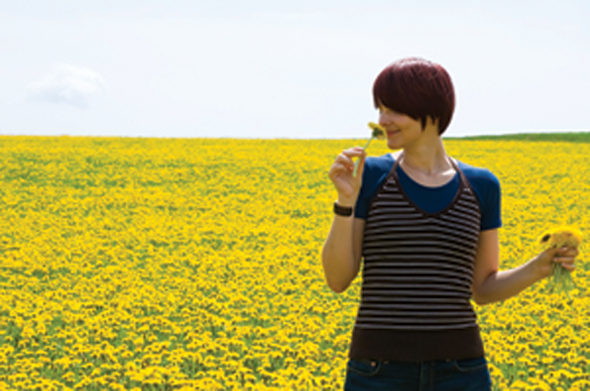Watery eyes, going through boxes of tissues and feeling stuffy and congested; allergy season causes millions to feel downright miserable.
Seasonal allergies occur when the body has an abnormal immune response to allergens and other foreign substances like pollen from flowers, grass and trees (1). While having an allergy attack is no fun, the upside is that some natural supplements can offer a bit of a reprieve for allergy sufferers (once approved by a medical professional).
Tackling Inflammation
As much as allergy sufferers wish they could avoid the great outdoors until allergy season subsides, it is not a realistic approach to coping with seasonal allergies.
Allergies cause temporary (but uncomfortable) inflammation of the mucous membranes that line the nasal passages. When allergens enter the body of an allergy sufferer, his/her immune system releases histamines and other compounds that cause inflammation. This results in swollen sinuses, headaches, wheezing and all the symptoms we dread from allergy season (1).
Natural anti-histamines may help combat inflammation. These compounds inhibit the effect of histamines in the body by coating the receptors that receive histamine messages. The end result may be a properly functioning nasal and respiratory system that any allergy sufferer will appreciate (2).
One natural anti-histamine is quercetin, which is also known to have anti-inflammatory and antioxidant properties (3, 4). Quercetin is thought to modulate the behavior of the gene signal NF-kappaB, which determines how a cell manages stress and inflammation (a response to tissue injury).
A study about quercetin’s effects was conducted at Pepperdine University on cyclists to demonstrate its anti-inflammatory properties. During the trial, two mixtures of antioxidants and vitamins were compared with each other. One batch contained 300 mg of quercetin, while the other batch excluded it. Both mixtures contained B vitamins, vitamin C, vitamin E and green tea extract. The cyclists took 300 mg of each supplement twice a day for six weeks (3, 4). Time needed to complete a 30-km race and the time taken to finish the final five km of the course were significantly improved in those taking the quercetin mixture. No marked improvement was shown in the time trial performance in the antioxidant mix that lacked quercetin. The researchers attributed these results to quercetin’s anti-inflammatory benefits, which prevented sore muscles (3, 4).
Other studies specifically look at quercetin’s connection to allergies. In one study of 20 people with pollen-induced allergies, 200 mg of quercetin supplements reduced eye irritation and itching over an eight-week period. Moreover, animal studies have linked quercetin with reduced asthmatic reactions thanks to its anti-histamine properties (5).
One herb that contains quercetin (as well as vitamin K and carotene) is stinging nettle. Often used on painful muscles and joints, it may also help with allergies. Stinging nettle is said to have anti-inflammatory properties, which may reduce prostaglandin production in the body. Prostaglandins act like hormones to induce inflammation, pain responses and fever. Prostaglandins are produced when white blood cells come to the site of tissue inflammation. As previously noted, it is vital to prevent inflammation when it comes to allergy care.
In a Phytotherapy Research article, stinging nettle was found to have several anti-inflammatory properties (6). For instance, it inhibits H1 receptors, which blocks histamine production and release. Likewise, stinging nettle inhibits tryptase (a protein in mast cell involved with allergenic response), which stops the release of cytokines and chemokines. This may help keep healthy individuals from experiencing allergy symptoms such as sneezing, nasal congestion, and itchy and watery eyes, according to researchers. The herb also inhibits proinflammatory enzymes COX-1 and COX-2 , which blocks prostaglandin production. Last, it blocks prostaglandin D2 production, which is said to be a “primary pro-inflammatory mediator in allergic rhinitis.”
 Another anti-inflammatory agent that could benefit allergy sufferers is the omega-6 fatty acid GLA (gamma-linolenic acid). GLA is found in several plant-based oils like primrose, black currant and borage. It is said to reduce the onset of allergies (7). GLA is used by the body to make hormone-like substances that help regulate a healthy immune system (7). Taken in supplement form, GLA is converted into DGLA (dihomo-y-linolenic acid) and is believed to protect against inflammation (7, 8). Though there aren’t many studies confirming the link between GLA and allergy relief, researchers do believe that “women and children who are prone to allergies appear to have lower levels of GLA in breast milk and blood” (7).
Another anti-inflammatory agent that could benefit allergy sufferers is the omega-6 fatty acid GLA (gamma-linolenic acid). GLA is found in several plant-based oils like primrose, black currant and borage. It is said to reduce the onset of allergies (7). GLA is used by the body to make hormone-like substances that help regulate a healthy immune system (7). Taken in supplement form, GLA is converted into DGLA (dihomo-y-linolenic acid) and is believed to protect against inflammation (7, 8). Though there aren’t many studies confirming the link between GLA and allergy relief, researchers do believe that “women and children who are prone to allergies appear to have lower levels of GLA in breast milk and blood” (7).
Some allergy sufferers may turn to echinacea as a way of supporting a healthy immune system. This herb—also a mainstay of the cold/flu category—has received a lot of negative attention lately. Researchers from the University of Wisconsin–Madison School of Medicine and Public Health concluded that the herb may have a minimal effect on fighting the common cold. Of note, most echinacea products are marketed for immune health, not cold treatment. In fact, 14 clinical trials found that echinacea reduced the chances of one having a cold by 58% (9). Some research also suggests that echinacea may be effective in helping with seasonal allergies, also.
Probiotics for Allergy Relief
Probiotics are well known in the digestive health category, but they may have some benefits to allergy sufferers, too.
Of the many probiotics available, Lactobacillus acidophilus is said to help benefit those with allergy symptoms. L. acidophilus is naturally found in the intestines and may help normalize the balance of bacteria in the colon (10).
L. acidophilus L-92 was tested on those allergic to Japanese cedar-pollen (JCP). Data showed that drinking a fermented milk with this probiotic strain “improved the symptoms of Japanese cedar pollinosis, thereby contributing to reduce the dose of concomitant medications. However, no blood parameter was significantly affected in these trials” (10).
The International Journal of Food Microbiology published a double-blind, placebo-controlled trial on the effects of other probiotic strains: Lactobacillus GG (LGG) and L. gasseri TMC0356 (11). Forty participants with a history of JCP were monitored for 10 weeks. Either fermented milk with probiotics or a placebo yogurt was given to the subjects. It was determined that the probiotics greatly decreased nasal blockage after just nine weeks. Furthermore, the tested strains of lactic acid bacteria affected cytokine production and LGG inhibited interleukin (IL)-4 and IL-5 production (11). These cytokines are involved in regulating immune responses. TMC0356 suppressed IL-5 production. Stated the researchers, “The effects of LGG and TMC0356 might arise at least partly from their specific down-regulation of the human Th2 immune response.”
Nasal Irrigation
While not a supplement, nasal irrigation (i.e., flushing the nostrils with a special solution) is becoming more and more popular among those with seasonal allergies. With the use of a neti pot, for instance, allergy sufferers may breathe easier, say proponents. Here’s how the neti pot works. One fills the teapot-shaped device with lukewarm water; sometimes, a saline solution of salt and water are combined. As the water is poured into the sinuses, it irrigates the passages and may help flush out bacteria, pollen and other irritants. It’s worth mentioning that if the solution is mixed correctly, one should experience no discomfort. Some who have used the neti pot have a lesser need for nasal sprays and antibiotics (12).
Other shoppers prefer sprays. A November 2010 survey was conducted to gauge users’ preferences of a branded nasal irrigator (containing 50% saline and a 50% mixture of oils like wintergreen, spearmint, pine, cinnamon and other ingredients), a neti pot or a saline rinse (12). Overall, 91% of the participants, who suffered from allergy-induced nasal congestion, reported that the branded irrigator was “very effective” at cleansing the nasal passages. The group preferred this method to a nasal saline spray or a neti pot, believing it was more effective, easier to use and less messy (13).
Children and Allergies
Children also may experience their fair share of seasonal allergies. And, while we may not be able to prevent allergies from occurring in children, we can do our part to make sure that they are more comfortable if they do experience symptoms.
First, advise clients to discuss remedies with a pediatrician before starting any new supplement regime. Next, there are several things that can be done around the house to make sure it is as free of allergens as possible. All air-conditioning and heating units should be cleaned according to schedule. Using high-efficiency particulate air (HEPA) filters are a great way to decrease the amount of allergens from the air (14). Keeping humidifiers clean and making sure that dust is vacuumed away regularly can help, too. WF
References
1. PDRhealth, “Seasonal Allergies,” www.pdrhealth.com/disease/disease-mono.aspx?contentFileName=BHG01AL10.xml&contentName=Seasonal+allergies&contentId=134, accessed Jan. 26, 2011.
2. Prevention’s Healing with Vitamins, (Rodale, Emmaus, PA, 1996).
3. M. Ryan, “Give Your Immune System a Boost with Quercetin,”www.usatriathlon.org/resources/multisport-zone/fuel-station/give-your-immune-system-a-boost-with-quercetin, accessed Jan. 6, 2011.
4. University of Maryland Medical Center, “Quercetin,” www.umm.edu/altmed/articles/quercetin-000322.htm, accessed Jan. 11, 2011.
5. J. Challem, “Quercetin: More Energy, Fewer Allergies: This Powerful Antioxidant Can Boost Stamina and Reduce Blood Pressure,” Better Nutrition, March 2010.
6. HerbalScience, “HerbalScience Research Identifies Key Bioactives in Nettle Extract That Inhibit Inflammation Associated with Seasonal Allergies,” press release distributed Aug. 26, 2009, www.herbalsciencegroup.com/pdf/aol.pdf, accessed Jan. 19, 2011.
7. University of Maryland Medical Center, “Gamma-Linolenic Acid,” gamma-linolenic-000305.htm, accessed Jan. 6, 2011.
8. University of Maryland Medical Center, Omega-6 Fatty Acids, www.umm.edu/altmed/articles/omega-6-000317.htm, accessed Jan. 19, 2011.
9. University of Maryland Medical Center, “Echinacea,” www.umm.edu/altmed/articles/echinacea-000239.htm, accessed Jan. 10, 2011.
10. University of Maryland Medical Center, “Lactobacillus acidophilus,” www.umm.edu/altmed/articles/lactobacillus-acidophilus-000310.htm, accessed Jan. 11, 2011, Effect of Milk Fermented with Lactobacillus acidophilus Strain L-92 on Symptoms of Japanese Cedar Pollen Allergy: A Randomized Placebo-Controlled Trial, Biosci. Biotechnol. Biochem. (2005).
11. M. Kawase, et al., “Effect of Fermented Milk Prepared With Two Probiotic Strains On Japanese Cedar Pollinosis in a Double-Blind Placebo-Controlled Clinical Study,” Int. J. Food Microbiol. 128 (3) 429–434 (2009).
12. “Nasal Saline Irrigation and Neti Pots,” www.webmd.com/allergies/sinus-pain-pressure-9/neti-pots, accessed Jan. 13, 2011.
13. “The Benefits and/or Patient Preference in the use of an Herbal Enhanced Nasal Spray v/s an OTC Nasal Saline Spray v/s the Neti Pot,” material supplied by Dr. Neuzil's Irrigator.
14. “Remedies for Seasonal Allergies in Toddlers,”www.livestrong.com/article/138776-remedies-seasonal-allergies-toddlers/, accessed Jan. 19, 2011.
Published in WholeFoods Magazine, March 2011









